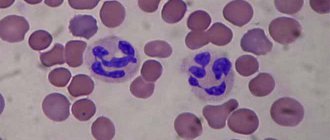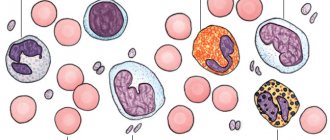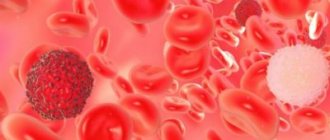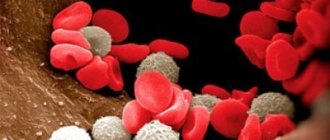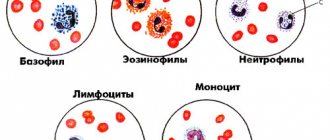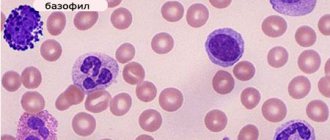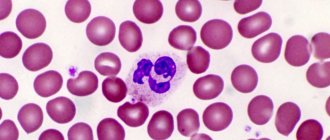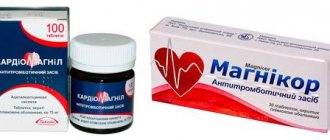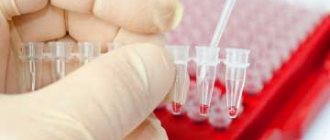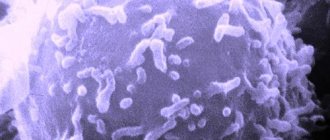Decreased neutrophils – neutropenia
Neutropenia is a reduced concentration of neutrophils and other granulocytes in the blood. It can be physiological and pathological. Physiological neutropenia occurs during excessive physical exertion, during pregnancy, after eating or stress. This condition is caused by the influence of various exogenous factors:
- radiation radiation,
- toxic substances - poisons and chemicals,
- some medications - antibiotics, immunosuppressants, hormones, cytostatics.
Physiological neutropenia does not pose a threat to human life and goes away on its own after the provoking influence is eliminated.
The cause of the pathological form is always a disease . Such neutropenia requires additional examination to identify the cause of the disorder.
Diseases in which the level of neutrophils in the blood decreases:
- viral infections - ARVI, chicken pox, hepatitis, rubella, measles, HIV;
- generalized fungal infection;
- chronic inflammation;
- radiation sickness;
- hematological disorders - agranulocytosis, anemia;
- hereditary forms of cyclic and severe congenital neutropenia;
- helminthiasis and parasitosis;
- malignant bone marrow tumors;
- allergic reactions - anaphylactic shock.
As a result of these pathologies, the bone marrow produces fewer neutrophils. A long-term inflammatory process depletes the human body and disrupts its functions. Blood cells are actively dying, the neutrophil series does not have time to be replenished with new forms. Some medications have a direct inhibitory effect on myelopoiesis, the process of neutrophil formation.
Neutropenia is a polyetiological condition. When making a diagnosis, this indicator is rarely assessed in isolation. In the hemogram, the ratio of various leukocyte fractions plays a key role.
Table: the combination of different leukocytes is normal
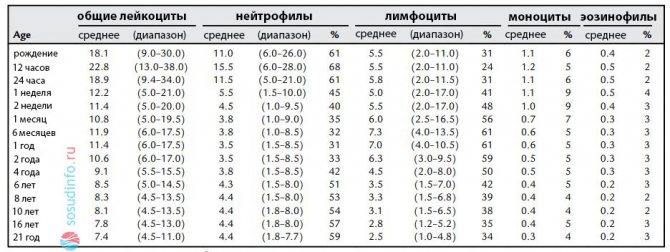
Normal indicators
Lymphocytes are responsible for the adaptive function of the immune system. This means that the ability to resist infection adapts to the environment as we age.
These particles belong to one of the following categories:
- T-lymphocytes – contribute to the formation of thymus and thymus cells; play an auxiliary role in the process of synthesis of signal substances;
- B-lymphocytes - take part in the production of bone marrow cells, which allows us to call them the “parents” of the body’s immune function; with their help, antibodies are produced.
- natural “killers” – secrete cytotoxins that help cope with pathological cells.
Note! Lymphocytes are low when their content in the blood of adults and children under 6 years of age is less than 25 and 45%, respectively.
High lymphocytes make it clear that the body has the following ailments:
- viruses;
- tuberculosis;
- lymphocytic leukemia;
- hyperthyroidism – increased production of thyroid hormones;
- lymphosarcoma.
Depending on the increased or decreased portion of the corpuscles, the state of the body and the presence of diseases of viral etiology are judged. Elevated lymphocytes will indicate inflammation. Therefore, it is imperative to visit a doctor after a disappointing analysis.
It is worth noting the possibility of human vaccination, which opens up thanks to lymphocytes. This is possible due to the fact that the bodies contain memory cells. They store antigens in a coded state.
This indicator is designated neut in a blood test of type wbc; two subgroups of these cells are distinguished. Inside the body, there are 2 phases of granulocyte maturation; this process takes place in the bone marrow. Initially, the cells are called myelocytes, after which they turn into metamyelocytes. They are formed exclusively inside the bone marrow and do not enter the blood, so the WBC analysis should not detect them.
At the next stage, they look like a rod, which is where the name of the form comes from – rod-shaped. After maturation, the cells acquire a segmented nucleus; at this stage, segmented leukocytes are formed. The norm of neutrophils in the blood is determined by these two types of cells: wbc analysis indicates the percentage of the total number. From the total number of leukocytes, the ratio of each type is calculated: this is called the leukocyte formula.
7 days from birth
7 days from birth
After a general analysis, the doctor pays attention to the number of leukocytes. If they are decreased or increased, this indicates the possible development of some pathology. A deviation in the indicators of one of the types of leukocytes will indicate a specific type of disease. The main task of these cells is to fight fungal and viral diseases. Doctors have established the norm of neutrophils in the blood of children, which indicates the absence of pathologies.
- In the first days of life, the child should have 50-70% segmented and 5-15% band.
- The number of these cells by the end of the first week should be 35-55% and 1-5%.
- After two weeks, the indicator of rod cells will be 1-4%, and segmented cells - 27-47%.
- By the end of the month of life, the child will have 1-5% band, 17-30% segmented, and by the year 1-5% and 45-65%.
- 1-4% and 35-55% are the norm for children 4-6 years old.
- At the age of 6-12 years, the indicators are 1-4% band-nuclear, 40-60% segmented.
For diagnosis, indicators in the analysis are important not only the independent norm of neutrophils. The ratio between all segmented, young cells must be taken into account, which may indicate the presence of some neutrophilic shift. To determine the presence of a particular disease, the individual number of rod and segmented cells is not significant.
Certain fluctuations in the normal number of immune cells are observed only in the first years of a person’s life. In adulthood, this value always remains at the same level. If immune cells are low or high, this indicates the development of the disease. The norm of neutrophils in the blood of women should be as follows: 40-60% segmented cells and 1-4% band cells.
The gender of a person does not matter when determining the normal level of protective cells. The main parameter is age, for example, in a child under one year old there are noticeable jumps in the content of leukocytes. The norm of neutrophils in the blood of men is the same as that of women: 1-4% rod- and 40-60% segmented cells. A change in this indicator will be associated with inflammatory or infectious processes occurring in the body.
Neutrophils
Increased lymphocytes – lymphocytosis
Lymphocytosis is a condition in which the absolute number of lymphocytes in the blood exceeds 3.6x109. In this case, the level of neutrophils is reduced, and the level of monocytes is increased.
Lymphocytes perform a protective function, destroying viruses, atypical cells, and pathogenic fungi. When the body is attacked by these foreign agents, lymphocytosis occurs. There are other processes in which the concentration of these immune cells in the blood increases. An increased level of lymphocytes indicates the onset of inflammation in the body. The doctor, analyzing the accompanying manifestations, determines the location of the lesion.
Pathologies in which the concentration of lymphocytes in the blood increases:
- viral infections - chickenpox, measles and rubella in a child, influenza and ARVI in an adult;
- Infectious mononucleosis;
- specific bacterial infection - tuberculosis, syphilis, brucellosis, diphtheria;
- acute and chronic lymphocytic leukemia;
- lymphosarcoma;
- hyperthyroidism;
- autoimmune disorders.
These diseases are manifested by lymphocytosis and neutropenia. As a result of hyperplasia of lymphoid tissue, hypersecretion of lymphocytes occurs, which intensively enter the blood. This is observed when the process is chronic, long-term recurrent course of the disease and when inflammation subsides.
Lymphocytosis with an increase in neutrophils is observed with purulent inflammation - sepsis, peritonitis, tonsillitis, pyelonephritis; necrotic processes - stroke, frostbite, gangrene, extensive burns; lead or alcohol intoxication; oncopathology.
Lymphocytosis is sometimes observed in completely healthy people. The physiological form occurs when:
- pregnancy,
- menses,
- poor nutrition,
- prolonged fasting,
- alcohol abuse,
- smoking,
- high physical activity,
- hard work
- chronic stress,
- general exhaustion,
- violation of blood donation rules.
An increased level of lymphocytes in the blood is considered a temporary phenomenon. Lymphocytosis occurs after any operation. It is always found in individuals who have undergone splenectomy.
monocytes increased, neutrophils decreased
Monocytes are the largest type of blood cell.
Monocytes are commonly found in loose connective tissue, spleen, lymph nodes, and bone marrow. Monocytes (mononuclear phagocytes) as a component of the human immune system are actively involved in protecting the body from viral invasion. The elimination of pathogens by monocytes mainly occurs through phagocytosis, as well as the synthesis of degradative enzymes and reactive oxygen metabolites. The rapid growth of the monocyte/macrophage population at the site of infection provides an immediate immune response that can limit the spread of the virus in the early stages of infection.
An increase in the level of monocytes in the leukocyte formula may indicate...
- infections such as infectious mononucleosis, tuberculosis, syphilis, brucellosis, subacute bacterial endocarditis, rickettsial infections and protozoal infections (malaria, leishmaniasis), fungal invasions.
- autoimmune diseases (ulcerative colitis; rheumatoid arthritis),
- hematological diseases: lymphogranulomatosis, leukemia, sarcoidosis.
Neutrophils are the most numerous type of white blood cells in the blood. Neutrophils participate in the primary defense of the body, acting by phagocytosis of pathogens. In the most common cases, low levels are caused by chemotherapy: About half of cancer patients have low neutrophil counts during chemotherapy.
Also, a low level of neutrophils (neutropenia) may indicate disorders such as :
- Hepatitis A, B and C, HIV/AIDS, malaria, tuberculosis, Lyme disease and other infections.
- Sepsis.
- Leukemia.
- Myelodysplastic syndromes and myelofibrosis are bone marrow pathologies.
- Alcohol abuse and alcoholism.
- Vitamin deficiency - most often vitamin B12, folic acid
- Copper deficiency.
Decreased neutrophils and increased lymphocytes at the same time
The leukocyte formula is important when making a diagnosis. It is in the leukogram that changes most often occur. However, the total number of leukocytes remains normal.
- Viral infections are characterized by an increase in lymphocytes and a decrease in neutrophils. The absolute level of leukocytes in the blood does not exceed normal limits. Such leukogram data indicate the body’s active fight against viruses. They are often obtained at the incubation stage, when there are no symptoms of the disease, and the microbes have already entered the body and begun their life activity. Neutropenia and lymphocytosis are observed in persons who have recently had acute respiratory viral infections. Lymphocytes migrate to the site of inflammation, multiply and differentiate to provide reliable antimicrobial protection. It takes some time for blood counts to normalize. When recovery occurs, the concentration of leukocytes is restored.
- Cancers are characterized by an imbalance of immune cells that form and mature in the bone marrow. Tumors of an organ disrupt its functioning. At the same time, the level of lymphocytes increases and the number of neutrophils in the blood decreases. Aplastic anemia is manifested by pallor, impotence, dizziness, and bleeding. In the absence of timely diagnosis and adequate treatment, the disease develops into leukemia. The most common oncohematological diseases include chronic lymphocytic leukemia and non-Hodgkin lymphoma. B lymphocytes accumulate in the bone marrow, lymph nodes, and liver. These oncopathologies are characterized by a slow course and specific symptoms.
- Neutropenia with lymphocytosis is also observed in allergic reactions . Such research results allow doctors to determine the presence of a tendency to allergies. At the same time, along with lymphocytes, eosinophils are also increased.
- Many lymphocytes in the blood are found not only during respiratory infections , but also during tuberculosis, brucellosis, typhoid fever, systemic lupus erythematosus, lymphogranulomatosis, and renal pathology.
- Purulent-destructive and vascular diseases also require a hemotest, which can be used to detect lymphocytosis and neutropenia. These include: abscesses, phlegmons, boils, gangrene, heart attack, stroke.
Decreased neutrophils and increased lymphocytes in the blood are a common sign of a bacterial or viral infection. Extensive infection is accompanied by the release of an infectious agent into the bloodstream. Neutrophils quickly die after interacting with the pathogen, and the bone marrow does not have time to produce them in sufficient quantities. Patients experience the main symptoms of the pathology: fever, chills, lethargy, rapid heartbeat, hyperhidrosis, tachypnea, hypotension. If signs of intoxication syndrome appear, you should immediately consult a doctor. To make a correct diagnosis and avoid mistakes, it is necessary to evaluate the quantitative indicators of blood cells not in isolation, but in the totality.
In children, low neutrophils and high lymphocytes are normal. This crossover is due to an incompletely formed immune system. A common reason for deviation is vaccination. In response to foreign invasion, the body reacts by producing antibodies - lymphocytes. In this case, granulocytes are not produced in full.
Why are lymphocytes elevated and neutrophils decreased in adults and children?
When a blood test shows that neutrophils are low and lymphocytes are high in an adult or child, this is alarming.
Therefore, many immediately begin to search on the Internet what this could mean. It should be noted that even a doctor cannot make an accurate diagnosis using these indicators alone.
Therefore, if the leukocytes deviate from the norm, the doctor will prescribe additional examinations, based on the results of which a diagnosis will be established.
Immune system cells
The most important role in human immunity is played by leukocytes, white blood cells.
It is generally accepted that there are five types of white blood cells in the body, the number of which fluctuates greatly throughout life.
In this case, it often happens that one type, for example, neutrophils, decreases, while another (lymphocytes) increases. This is explained by the fact that their different types carry different functional loads in the functioning of the immune system.
The level of white blood cells in a child is usually increased compared to their number in an adult. This happens because the child’s immune system has to resist various infections much more often.
The leukocyte norm in children and adults should be:
- in a newborn child: from 10-22 billion per liter;
- in children at six months – 9-11 billion per liter;
- from one to two years – 4-12 billion per liter;
- from 2 to 6 years – 4-10 billion per liter;
- from 6 and older: 4-8 billion per liter.
During the examination, not only the total number of leukocytes is studied, but also their ratio to each other. Particular attention is paid to lymphocytes and neutrophils.
The Neutrophil Challenge
Neutrophils are the most common type of white blood cell. They have a short lifespan (from 5 to 90 hours) and have the ability to penetrate body tissues better than other white blood cells. The reason for this is the activity of these cells and their small size.
Neutrophils instantly respond to signals of inflammation in the body and are sent through the blood vessels to its source. If the infection is too severe, they die and form pus, attracting other types of white blood cells. Neutrophils also secrete various antibacterial substances and enzymes.
This type of immune system cells is usually divided into band and segmented cells. Segmented neutrophils have the main function in the immune system, since they have a greater ability than band neutrophils for phagocytosis, that is, to absorb and dissolve pathogenic microorganisms and particles.
In a newborn child, the number of band neutrophils ranges from 5 to 12% of the total number of leukocytes.
Then their number decreases and fluctuates between 1 and 5%. Segmented neutrophils are of greater importance in the functioning of the child’s immune system. In children from one to six years of age, the proportion of segmented cells ranges from 50 to 70%, then decreases and in an adult it remains in the range of 40-60%.
Lymphocyte work
The task of lymphocytes is to recognize foreign elements and neutralize them with the help of antibodies and cytotoxins. Their number in a child’s immune system is twice that of an adult. The reason for this is that lymphocytes perform a unique adaptive function in the immune system, and the child’s immunity adapts to the environment.
Lymphocytes are divided into three main categories:
- t-lymphocytes - produce thymus or thymus cells, perform auxiliary functions, synthesizing signal substances and cytotoxins;
- b-lymphocytes - produce bone marrow cells, perform the main immune function, producing antibodies.
- natural killers.
After meeting a pathological agent, t- and b-lymphocytes are activated. Their structure contains special memory cells that encode entire lists of antigens, making vaccination successful. Therefore, even after a long time, they are able to instantly respond to pathogens that have already penetrated the body.
Killer cells are part of the innate immune system. They release cytotoxins towards infected and modified cells (eg tumors).
Features of the analysis
Doctors advise taking a general blood test annually for timely detection of pathological processes. An analysis is also prescribed if the patient complains of certain symptoms (pain, temperature, etc.).
A white blood cell count can reveal hidden infections and guide the doctor on what type of examination to prescribe. This is especially important for identifying diseases that are difficult to diagnose (autoimmune diseases, immunodeficiencies, blood diseases). Also, deciphering the analysis helps to monitor the effectiveness of chemotherapy and radiation therapy for cancer patients.
The blood test procedure involves taking a blood sample from a finger or a vein in the arm. The material collection procedure generally proceeds without problems. But sometimes complications are possible when the specialist is unable to determine the location of the vein or the needle gets stuck in the tissue.
Data interpretation
Depending on whether leukocytes, neutrophils and lymphocytes are increased or decreased, the cause of the disease is determined by a blood test. The algorithm is as follows:
- Acute viral infection – leukocytes are increased, lymphocytes are increased, neutrophils are decreased.
- Chronic viral infection - leukocytes are normal or low, lymphocytes are at the upper limit of normal or high, neutrophils are at the lower limit of normal or low.
- Acute bacterial infection – leukocytes are increased, neutrophils are increased, lymphocytes are decreased.
- Chronic or local bacterial infection - the same signs as for acute, but to a lesser extent, closer to normal.
As can be seen from the above formula, lymphocytes react primarily to viruses, and neutrophils - to bacteria.
It is worth noting that bacteria are a much more complex biological formation than viruses. As living beings, they have their own DNA and have the ability to reproduce.
While the virus is only capable of parasitizing the body of the host cell in which it produces its copies.
The most common viral infections are influenza virus, herpes, hepatitis, measles, rubella, encephalitis and others. Among the bacterial diseases we list such as diphtheria, tetanus, tuberculosis, E. coli, syphilis and others.
Diagnostic features
Before making a diagnosis, the doctor takes many factors into account. These include treatments and medications, symptoms, medical history, gender, age and heredity.
When preparing for the test, the patient should remember that taking certain medications can increase or decrease the number of white blood cells in the blood. Therefore, you should definitely notify your doctor about taking them. These medications include:
- Antibiotics.
- Antihistamines.
- Diuretics.
- Corticosteroids.
- Relaxers.
- Clozepine.
- Heparin.
- Chemotherapy and radiation therapy drugs.
A lack of white blood cells is called leukopenia and can be caused by a number of diseases. These include HIV, autoimmune disorders, and bone marrow diseases. White blood cells can be reduced in severe forms of infection, diseases of the liver and spleen, and radiation therapy.
An increased number of white blood cells (leukocytosis) occurs with anemia, bone marrow tumors, and leukemia. May be due to tissue inflammation, arthritis, stress, pregnancy; allergies, asthma.
After diagnosing the cause of an increased or decreased number of white blood cells, the doctor draws up a treatment plan, during which it is necessary to take a second blood test. If the number of leukocytes does not change, this indicates a worsening of the condition, which requires correction of the treatment regimen.
Source: https://ProAnalizy.com/krov/klinicheskij/neytrofily-ponizheny-limfotsity-povysheny.html
Diagnostics
Lymphocytes and neutrophils are blood cells that perform vital functions and can tell a lot about the patient’s condition. In order not to miss the development of serious diseases, it is necessary to take a general blood test annually. Leukocytes are determined according to special standard standards. The identified discrepancy characterizes the high activity of blood cells and signals the beginning of the development of pathological processes. Based on the results of the study, even hidden, asymptomatic diseases can be detected.
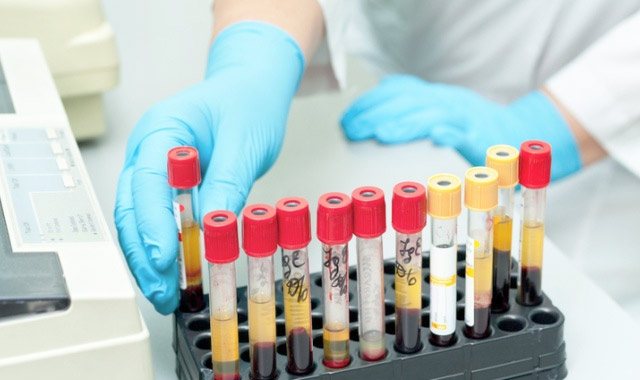
The analysis requires capillary blood from the patient. They take it in the morning, strictly on an empty stomach, having eliminated smoking and alcohol for several days. You should inform your doctor in advance about taking vital medications. The patient should be as calm as possible physically and psychologically before collecting the material. Only a specialist can correctly decipher the results of the study. He evaluates all hemotest indicators in aggregate. The leukocyte formula deserves special attention, reflecting the ratio of individual types of leukocytes in percentages and numbers. Leukocyte calculation allows you to determine the number of white blood cells per unit volume. The content of some fractions changes due to an increase or decrease in others.
An extended blood test with leukocyte count is required for patients with:
- acute infectious and inflammatory diseases,
- immunodeficiency conditions,
- frequent relapses of bacterial and fungal infections,
- pregnant women.
By analyzing a high or low percentage of white blood cells, the doctor may suspect a patient has a rare autoimmune disorder, hematological disease, or immunodeficiency. Based on the leukocyte formula, one can draw a conclusion about the development of complications, the course of the pathological process and the prognosis of the disease. Using leukogram results, doctors differentiate between viral and bacterial infections.
- Viral damage is characterized by an increase in lymphocytes and a decrease in neutrophils.
- Infectious diseases caused by bacteria are manifested by a shift in the leukocyte formula to the left - an increase in neutrophilic leukocytes and a relatively low content of lymphocytes.
Laboratory indicators do not allow making a final diagnosis of the existing pathology. To do this, it is necessary to conduct a more detailed examination of the patient, including clinical signs, anamnestic data, instrumental methods and a whole list of analyzes of biological material.
To determine the cause of the disorder, the doctor needs to find out:
- patient complaints,
- objective signs,
- anamnesis,
- heredity.
Taking certain medications can affect the number of certain fractions of leukocytes in the blood . These include antibiotics, antihistamines, diuretics, corticosteroids, anticoagulants, and muscle relaxants. It is necessary to inform the doctor about the treatment performed. Chemotherapy and radiation therapy also cause an increase in the proportion of white cells in the blood. A prolonged decrease in neutrophils and an increase in lymphocytes require additional examinations - blood tests for tumor markers, tomographic, radiographic and ultrasound examinations of internal organs.
After receiving the results of tests and tests, the doctor makes a final diagnosis and draws up a treatment plan.
Lymphocytes and neutrophils are increased or decreased: deciphering the ratio in adults
A blood test can be called one of the most commonly used research methods in diagnosing diseases.
Based on the state of the blood and its indicators, the doctor can judge the presence of any specific ailments and the general condition of the patient, as well as the need for additional in-depth research.
In the article you know everything about the ratio of lymphocytes and neutrophils in the blood, when they are increased or decreased in adults and children.
What are lymphocytes and neutrophils and their importance in the blood
Lymphocytes are special blood cells belonging to the group of leukocytes. Their role in the human body is very important.
It is these cells that are responsible for protecting the body from harmful microorganisms, or more precisely, for the level of resistance to their effects. Lymphocytes are the first, and perhaps the main barrier and protection against cancer cells.
A change in the level of lymphocytes is always regarded as an alarming signal indicating some kind of disorder.
Lymphocytes are divided into several types, each of which has its own unique function, but together they create a reliable barrier to many ailments.
Neutrophils also belong to the group of leukocytes and are the most numerous type. Their task in the body is to quickly destroy invading harmful bacteria and other elements. Their functionality and importance has 2 special aspects:
- Some doctors compare these cells to kamikazes, because when they encounter viruses or bacteria in the body, neutrophils quickly absorb them, which is called phagocytosis, after which lysis begins - the breakdown of harmful elements inside the neutrophils. After this, the cells die.
- The maturation of cells has 6 stages, while some of them are always present in the blood in normal quantities, and the other part is activated only when complex diseases occur. In the body, all these groups are present at different stages simultaneously, performing their functions and protecting the body from possible attacks from the outside. Of particular importance is the ratio between neutrophils of different stages, since a shift in the leukocyte formula is practically a key diagnostic indicator.
Norm of lymphocytes and neutrophils in adults and children
The results of blood tests always reflect the number of lymphocytes as one of the key indicators. In earlier times, in laboratories, calculations of this parameter were carried out only manually using powerful microscopes, but now similar work is performed by automatic analyzers, which has greatly simplified the research.
However, to this day, there is often confusion in the results, since the standards of manual counting and the analyzer differ. Quite often, the form indicates the value of automatic calculation at the norm for manual research. And for children, the norms may not be specified at all.
In addition, the value can be specified in both relative and absolute form. The norms of lymphocytes are considered to be:
| Relative number of lymphocytes in % | Absolute value in x109 cells per liter |
| Newborns - from 15 to 35 | Newborns - from 0.8 to 9 |
| From 1 month to 1 year – from 45 to 70 | From 1 month to 1 year – from 0.8 to 9 |
| From 1 year to 16 years – from 30 to 50 | From 1 year to 16 years – from 0.8 to 8 |
| Adults – from 30 to 40 | Adults – from 0.8 to 4 |
The indicator of neutrophils, as well as lymphocytes, does not depend on a person’s gender. The norms for this value are developed exclusively for age groups.
As a rule, the analysis does not indicate the general group of neutrophils, but rather divides them into band and segmented ones. Other types of neutrophils are not taken into account in the results, since they appear only in sick people and their presence in the analysis may indicate the presence of disorders and deviations from the norm.
The following are considered norms:
| Age | Normal neutrophil count in % | |
| Rod | Segmented | |
| Newborns | 5 – 12 | 50 – 70 |
| From 1 day to 1 week | 1 – 5 | 35 – 55 |
| At 2 weeks | 1 – 4 | 27 – 47 |
| At 1 month | 1 – 5 | 17 – 30 |
| At 1 year | 1 – 5 | 45 – 65 |
| From 4 to 5 years | 1 – 4 | 35 – 55 |
| From 6 to 12 years | 1 – 4 | 40 – 60 |
| In adults | 1 – 4 | 40 – 60 |
Lymphocyte to neutrophil ratio
Since the purpose of lymphocytes is to quickly recognize invading harmful elements, an increase in their number at the onset of any disease is a normal and completely natural reaction of the immune system. With some ailments, for example, with different types of acute respiratory viral infections, the number of lymphocytes increases, and with influenza it decreases. In the presence of mononucleosis, their numbers increase very sharply and to serious numbers.
Neutrophils die by absorbing foreign harmful objects, so if their number increases, this may mean that a person has an acute bacterial infection.
These cells are divided into several types, but in healthy people there are usually only segmented neutrophils, which are mature cells and ready for the process of phagocytosis, as well as band neutrophils, which are immature.
As a rule, there are few band cells in the human body, which is considered normal, since the bulk of neutrophils in a healthy body are segmented, which provides proper protection and readiness to fight harmful elements.
In the presence of acute bacterial infections, the ratio changes , as mature cells die in the fight and the body begins to produce new ones.
If the total number of neutrophils (including band neutrophils) increases, we can conclude that there is an acute bacterial process. A decrease in the total number of these cells with an increase in immature cells indicates a massive bacterial infection.
The third important diagnostic aspect is eosinophils, which destroy harmful microorganisms that are too large for ordinary neutrophils.
For example, with ARVI, the number of lymphocytes sharply increases, but neutrophils and eosinophils remain normal. With influenza, an increase in neutrophils is observed, accompanied by a decrease in the number of lymphocytes, while eosinophils remain normal. In the presence of infectious type mononucleosis, a sharp increase in the level of lymphocytes is observed against the background of normal values of eosinophils and neutrophils.
In the presence of bacterial infections in an acute form, an increase in both lymphocytes and neutrophils can be observed, while a very large number of cells of the band category or their precursors, called myelocytes, as well as metamyelocytes or myeloblasts, which are usually observed only in the blood of sick people, are present.
In the presence of parasites or any allergic manifestations, normal values of lymphocytes and neutrophils are observed, but the number of eosinophils increases sharply.
Reasons for the synchronous decrease in neutrophils and increase in lymphocytes
When the results of a blood test show a decrease in the level of neutrophils (neutropenia), and the level of another type of leukocyte - lymphocytes - is increased, this is a fairly eloquent picture of pathological changes in the body.
To understand why there is such an “asymmetrical” decrease in some fractions in the blood and an increase in other representatives of the leukocyte formula. It is worth understanding the functions of both types of leukocytes.
Functions of neutrophils and lymphocytes
The tasks of white blood cells, called leukocytes, include providing a protective barrier against all kinds of infections and inflammatory processes, as well as absorbing pathogenic microorganisms and their breakdown products.
This complex defense system involves different leukocyte fractions, each with a strictly defined function.
For example, neutrophils, which are the largest fraction, are endowed with the ability to absorb harmful bacteria or viruses and break them down inside their bodies. This is done by mature cells called segmented cells. Having completed their mission, neutrophils themselves die, protecting other cells from the spread of microbes. How this happens - watch the video below.
Lymphocytes do not differ in such sacrifice, although they are also capable of destroying infectious agents, but their main task is to recognize pathogenic cells, including viral, fungal and tumor cells. Just like other fractions, lymphocytes are produced by the bone marrow, and when mature they enter the blood and then into the tissues of the body.
What does it mean that one faction decreases while another increases?
When an inflammatory process is detected in tissues, segmented neutrophils rush to the site of pathology, so their number in the blood may decrease - after all, the front of their work is located in the tissues. The reasons for this phenomenon may be:
- burns, injuries and other tissue damage;
- viral infections;
- severe inflammatory processes;
- radiation exposure;
- hypoplastic and aplastic anemia;
- chemical poisoning;
- agranulocytosis.
A sharp decrease in the level of segmented neutrophils may be the body’s response to the use of such intensive treatments as radiation or chemotherapy, as well as a number of other medications.
When segmented neutrophils are reduced with a simultaneous increase in lymphocytes, this often indicates that the body has already suffered the disease and the indicators will soon return to normal.
- problems with the thyroid gland;
- tuberculosis disease,
- the development of a viral infection or various forms of leukemia (acute or chronic lymphocytic leukemia).
When a blood test shows that lymphocytes are elevated and there are few neutrophils in the leukocyte formula, this indicates serious pathological changes in the body.
Normal indicators
For a general picture of the number of neutrophils and lymphocytes in the leukocyte formula, the percentage of these fractions relative to the total number of leukocytes is usually determined. As with most blood parameters, these numbers are slightly different for a child and an adult.
As can be seen from the table, in the first years of a child’s life the percentage of both fractions is approximately the same, however, in the blood of adults, neutrophils predominate, and the number of lymphocytes becomes significantly lower.
It is interesting that in the total number of neutrophils, the majority (up to 68%) are mature, that is, segmented, and their precursors, band neutrophils, do not exceed 5% of the total number of neutrophil cells.
What are the dangers of deviations from the norm?
It is clear that if the blood lacks a certain type of leukocytes responsible for destroying pathogens, the body’s immune defense is weakened. A reduced level of neutrophils leads to a worsening of the disease, because when there are many harmful cells, but they do not meet resistance, the body’s immune defense does not work.
When the pathological process takes on a protracted form, and this is signaled by an increased number of lymphocytes that detect antigens, but cannot cope with them on their own.
The greatest danger in a situation where the level of the neutrophil fraction is reduced is agranulocytosis, or the death of immature neutrophils; this condition requires hospitalization and long-term complex therapy.
If the results of a blood test show a decrease in the number of neutrophils while the number of lymphocytes increases, there is no need to panic or try to independently diagnose yourself or your child. There are many reasons for this condition, and they can only be understood through additional research. The most reasonable thing is to consult a doctor and follow his recommendations.
Share with friends:
https://redkrov.ru/sostav/leykocity/ponizheniye-nejtrofilov-uvelicheniye-limfocitov.html
Immune system cells
The most important role in human immunity is played by leukocytes, white blood cells. It is generally accepted that there are five types of white blood cells in the body, the number of which fluctuates greatly throughout life .
In this case, it often happens that one type, for example, neutrophils, decreases, while another (lymphocytes) increases. This is explained by the fact that their different types carry different functional loads in the functioning of the immune system. The level of white blood cells in a child is usually increased compared to their number in an adult. This happens because the child’s immune system has to resist various infections much more often.
The leukocyte norm in children and adults should be:
- in a newborn child: from 10-22 billion per liter;
- in children at six months – 9-11 billion per liter;
- from one to two years – 4-12 billion per liter;
- from 2 to 6 years – 4-10 billion per liter;
- from 6 and older: 4-8 billion per liter.
During the examination, not only the total number of leukocytes is studied, but also their ratio to each other. Particular attention is paid to lymphocytes and neutrophils.
